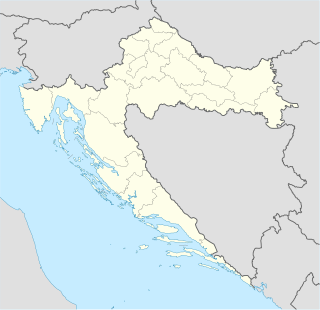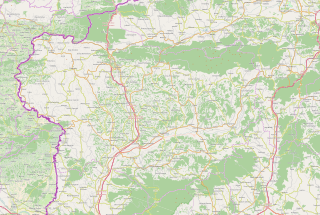
Jasenovac was a concentration and extermination camp established in the village of the same name by the authorities of the Independent State of Croatia (NDH) in occupied Yugoslavia during World War II. The concentration camp, one of the ten largest in Europe, was established and operated by the governing Ustaše regime, which was the only quisling regime in occupied Europe to operate extermination camps solely on their own for Jews and other ethnic groups. It grew quickly into the third largest concentration camp in Europe

Miroslav Filipović, also known as Tomislav Filipović and Tomislav Filipović-Majstorović, was a Bosnian Croat Franciscan friar and Ustashe military chaplain who participated in atrocities during World War II in Yugoslavia. Convicted as a war criminal in a Yugoslav civil court, he was executed by hanging in 1946.

Ljubomir "Ljubo" Miloš was a Croatian public official who was a member of the Ustashe of the Independent State of Croatia (NDH) during World War II. He served as commandant of the Jasenovac concentration camp on several occasions and was responsible for various atrocities committed there during the war. He fled Yugoslavia in May 1945 and sought refuge in Austria. In 1947, he returned to Yugoslavia with the intention of starting an anti-communist uprising. He was soon arrested by Yugoslav authorities and charged with war crimes. Miloš was found guilty on all counts and hanged in August 1948.

Vjekoslav Luburić was a Croatian Ustaše official who headed the system of concentration camps in the Independent State of Croatia (NDH) during much of World War II. Luburić also personally oversaw and spearheaded the contemporaneous genocides of Serbs, Jews and Roma in the NDH.

Stara Gradiška was a concentration and extermination camp in the Independent State of Croatia (NDH) during World War II. The camp was specially constructed for women and children of Serb, Jewish and Romani ethnicity. Victims also included communist and anti-fascist Croats and Bosniaks. It was established by the Ustasha regime in 1941 at the Stara Gradiška prison near the eponymous village as the fifth subcamp of the Jasenovac concentration camp.

Ivan "Ivo" Herenčić was a general in the armed forces of the Independent State of Croatia, a fascist puppet state, where he commanded a battalion of Ustaše Militia that committed many war crimes and atrocities on civilians in the NDH. Born in Bjelovar in Austria-Hungary, he completed secondary and tertiary education in Zagreb and Sarajevo in what was by then the Kingdom of Yugoslavia. In 1933, he left Yugoslavia to join the fascist and ultranationalist Croatian Ustaše movement in Italy. Late that year, Herenčić participated in an unsuccessful assassination attempt on the King of Yugoslavia, Alexander.

Nada Dimić was a Yugoslav Partisan who died in World War II and was proclaimed a People's Hero of Yugoslavia.

Gornja Rijeka is a municipality in the Koprivnica-Križevci County in Croatia.

Lobor is a city and municipality in the Northern Croatia. In 2011 census, there were 357,652 inhabitants in the area, 98.96% of which were Croats. During the first year of the World War II Ustaše established a concentration camp in Lobor, also known as Loborgrad concentration camp, for Jewish and Serb women and children. At least 200 of them died in it.

The Jastrebarsko children's camp held Serb children who had been brought there from various areas of the Axis puppet state, the Independent State of Croatia, during World War II. The children had been captured as a result of massacres and counter-insurgency operations conducted by the genocidal Ustaše-led government, its Axis allies and other collaborators since the Axis invasion of Yugoslavia and establishment of the NDH in April 1941. The camp was located in the town of Jastrebarsko, about 37 kilometres (23 mi) southwest of the NDH capital, Zagreb, and operated from 12 July until October 1942. Camp administration was provided by nuns of the Daughters of Charity of Saint Vincent de Paul order, with Ustaše guards.

The Holocaust in the Independent State of Croatia is a term which is primarily used in reference to the genocide of Jews, but sometimes, it is also used in reference to the genocide of Serbs and Romani (Porajmos), within the Independent State of Croatia, a fascist puppet state which existed during World War II, was led by the Ustaše regime, and ruled an occupied area of Yugoslavia which included most of the territory of modern-day Croatia, the whole of modern-day Bosnia and Herzegovina and the eastern part of Syrmia (Serbia). Of the 39,000 Jews who lived in the NDH in 1941, the United States Holocaust Memorial Museum states that more than 30,000 were killed. Of these, 6,200 were shipped to Nazi Germany and the rest of them were killed in the NDH, the vast majority were killed in Ustaše-run concentration camps, such as Jasenovac. The Ustaše were the only quisling forces in Europe who operated their own extermination camps for the purpose of killing Jews and members of other ethnic groups.

Diana Budisavljević was an Austrian humanitarian who led a major relief effort in Yugoslavia during World War II. From October 1941, on her initiative and involving many co-workers, she organized and provided assistance to mostly Serbian Orthodox women and children detained in the Ustaše camps in the Independent State of Croatia, a Nazi puppet state established in occupied Yugoslavia. The operation, known as "Action Diana Budisavljević", succeeded in saving around 10,000 children. Budisavljević described the course of the Action in a diary, starting with 23 October 1941 and the final entry on 7 February 1947. The diary was released in Croatian in 2003. After her story was better publicized in 2012, she received substantial posthumous recognition.
The Ustaše militia was the military branch of the Ustaše, established by the fascist regime of Ante Pavelić in the Independent State of Croatia (NDH), an Axis puppet state established from a large part of occupied Yugoslavia during World War II.
Stara Gradiška prison is a former prison at Stara Gradiška, Croatia.

Vlado Singer was a Kingdom of Yugoslavia politician and a prominent member of the Croatian Ustaše movement.

When World War II started, Zagreb was the capital of the newly formed autonomous Banovina of Croatia within the Kingdom of Yugoslavia, which remained neutral in the first years of the war. After the Invasion of Yugoslavia by Germany and Italy on 6 April 1941, German troops entered Zagreb on 10 April. On the same day, Slavko Kvaternik, a prominent member of the Ustaše movement, proclaimed the creation of the Independent State of Croatia (NDH), an Axis puppet state, with Zagreb as its capital. Ante Pavelić was proclaimed Poglavnik of the NDH and Zagreb became the center of the Main Ustaša Headquarters, the Government of the NDH, and other political and military institutions, as well as the police and intelligence services.

The Lobor concentration camp or Loborgrad camp was a concentration camp established in Lobor, Independent State of Croatia in the deserted palace of Keglevich family. It was established on 9 August 1941, mostly for Serb and Jewish children and women. The camp was established and operated by Ustaše, with 16 of its guards being members of the local Volksdeutsche community. Its inmates were subjected to systematic torture, robbery and murder of "undisciplined" individuals. All younger female inmates of the Lobor camp were subjected to rapes. More than 2,000 people were inmates of this camp, at least 200 died in it. All survived children and women were transported to Auschwitz concentration camp in August 1942 where they all were killed.

Đakovo was an internment camp for Jewish, and to a lesser extent Serb, women and children in the town of Đakovo in the Independent State of Croatia (NDH) that was operational between December 1941 and July 1942, during World War II.

The Gospić concentration camp was one of 26 concentration camps in the Independent State of Croatia during World War II, established in Gospić.

Ante Vrban was a Croatian major of the Ustaše Militia and later the Croatian Armed Forces of the Independent State of Croatia during World War II. He served as deputy commander of the Stara Gradiška concentration camp and was responsible for various atrocities committed there during the war. After the collapse of the Independent State of Croatia, he fled and sought refuge in Austria. In the summer of 1945, he returned to Yugoslavia with the intention of starting an anti-communist uprising. He was arrested by Yugoslav authorities and charged with war crimes. Vrban was found guilty on all counts and hanged in August 1948.

















